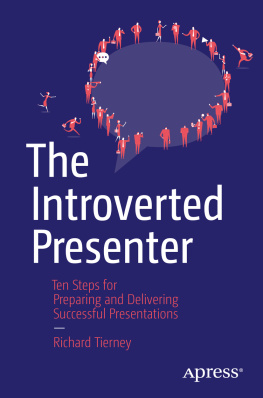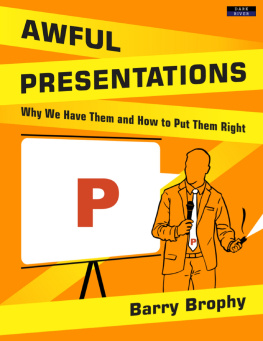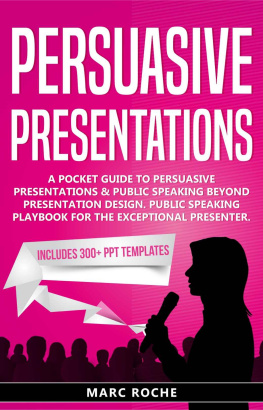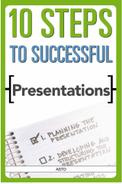There are lots of presenting help books out there, so why should you read this one? If you too are an introvert, then this chapter explains why.
An introvert will always need support when making presentations. Its simply not in our nature to stand in front of an audience and speak. We can do it, but its draining.
As youll see, Jung first named us introverts because we draw our energy from the outside inward . Pushing energy outward is just not in our nature, and while this book will teach you a process by which you can shine on the speakers platform, it will always leave you more exhausted than an extrovert.
The point is not to become an extrovert; thats not possible. The point is to acknowledge our makeup and evolve accordingly. And one of the most important things for introverts to get right is the structure and content of the presentation.
An extrovert giving a badly structured presentation will not do well, and an introvert will do just as badly but will feel much worse when doing it. So, its much more important for an introvert to be well prepared. My promise to you is that if you follow the guidelines I have laid out here, you will make great presentations, and youll have fun doing it. By following the guidelines in this book, you will get better and better because youll understand what youre good at and have coping strategies for what youre not suited to do.
Heres the alternative scenario. An accomplished professional speakerlets call him Davegives a great presentation at the companys annual conference. Mary, a salesperson in the audience, admires his stage presence and wants to emulate him. She does a search online andguess what!Dave has written a how-to book sharing his personal secrets and tips for presenting. So, Mary buys it.
Late into the night she studies Daves secrets, puts all he says into practice, and discovers that it does not work for her.
The reason is simple: Dave is an extrovert. From an early age he has been the star of the show; hes always the one who volunteers to be part of the nativity play, speech day, college debating society, and so on. Thats why hes a presenter and speakerhe was born to do it. No matter how often Mary reads the book, shes missing a vital part. Mary is an introvert so will still dread getting up to speak no matter how many books like Daves she reads.
The Introverted Presenter addresses this by leading you through the terror to a place of comfort and acceptance. Mary will never be a stand-up comic, but she can learn to present carefully prepared material her audience will connect with, and she can enjoy doing it.
I know this because Im an introvert just like you.
About Me
When I was at school, about 13, I was asked to stand in front of the class and speak. My mystified classmates saw me standing, wordless. My vision went red and then green; next I passed out. Teenage boys are vicious in the face of weakness, but no one mentioned it, and I was never asked to stand and speak again. My limiting belief , established that day, was that I could never make a speech.
My career took me into theater, concert, and television production. Always backstage or behind the camera, I was privileged to work with some of the biggest names in the performing world. I watched the way great pop stars connected with their audience, learned from seeing one of our greatest actors rehearse one of his West End appearances, and enjoyed the seemingly endless rehearsals famous directors spent on small, important pieces of stage direction.
You could always spot me in the audience; I was the one spending only half my time watching the stage. I was looking to see how the performance was received, as well as the techniques of those on stageall refreshingly nervous backstage.
I then worked in company events and corporate video. I found that I could help inexperienced presenters feel relaxed, hone their content, and become more effective. Over the years I got better and better at doing this. I have worked with main board directors of more than 60 of the Fortune 100 companies, as well as with leading charities and small Internet startups.
I have coached those making presentations in more than 30 countries, from a deserted Indonesian island to five-star conference centers and Buckingham Palace, from CEOs to disadvantaged children. Im trained in neurolinguistic programming (NLP), theater, film, business, and mentoring.
About five years ago I started my own consultancy and needed to demonstrate that I was an expert in the field. With a sinking heart, I realized that this meant I must volunteer to speak at industry events. I employed all that I hadunwittinglylearned through my career in the United Kingdom, in Europe, and further afield at more than 60 engagements globally. It worked. I proved what Id always suspected: that to become successful in any field, you must be a confident speaker, and that my limiting belief was based in myth. I recognized myself as an introvert and trained myself to speak, and Im now going to tell you how to as well.
Theres a survey quoted by almost all presentation training companies. The gist of it is that when people are asked what they fear most, public speaking is the highest out of all the replies. Its higher than death, which is number two. This supposedly academic piece of research is used by most trainers to say At a funeral, would you really rather be in the coffin instead of reading the eulogy? In fact, I can find no evidence that the survey really exists. There are a lot of these surveys that are regularly trotted out by professional speakers; most are pure invention, but they put some pseudo-academic veracity to a universal truth, usually the result of a dinner conversation made credible.
Before going further, I have to break some news to you: we are all going to die. As the Russians say, Life is dangerous; no one has survived it yet. So, if you ask what people most fear in their lives, death is kind of a given. No wonder the fictitious respondents focus on the things that will happen before the inevitable.
The truth supported by this invention is that most people are afraid of standing up in public because most people are introverts. My Myers Briggs type is INFP. The important thing here is that the first letter is an I . The choice is I or E : introvert or extrovert. More than 50 percent of us are I . Sources differ in their percentages, but everyone agrees that more people are introverted rather than extroverted.
The Myers-Briggs Type Indicator (MBTI) assessment is a psychometric questionnaire designed to measure preferences in how people perceive the world and make decisions. These preferences were extrapolated from the theories of Carl Jung first published in 1921.
Created by Katherine Cook Briggs and her daughter, Isabel Briggs Meyers, the test was designed to help women entering work for the first time. The initial questionnaire grew into the Myers-Briggs Type Indicator, which was first published in 1962.
CPP, Inc., the publisher of the MBTI instrument, calls it the worlds most widely used personality assessment with as many as 2 million assessments administered annually.
The test plots an individuals preferences on four dichotomies, or preferences:









